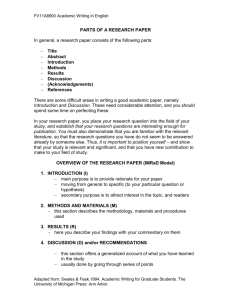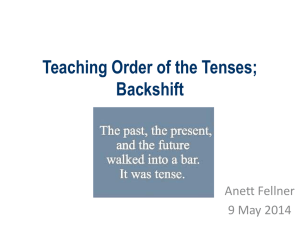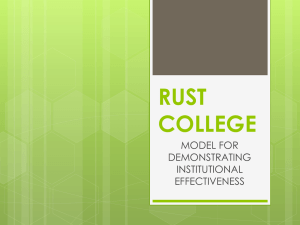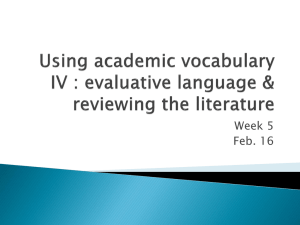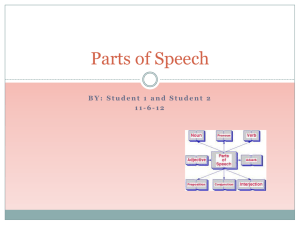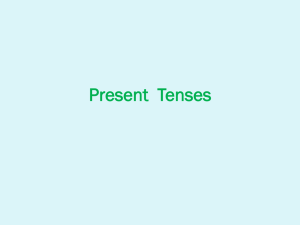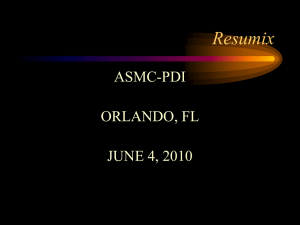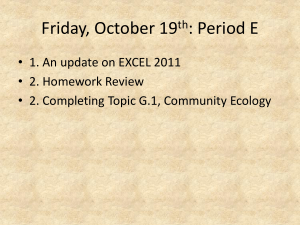Week 4: Using academic vocabulary III
advertisement
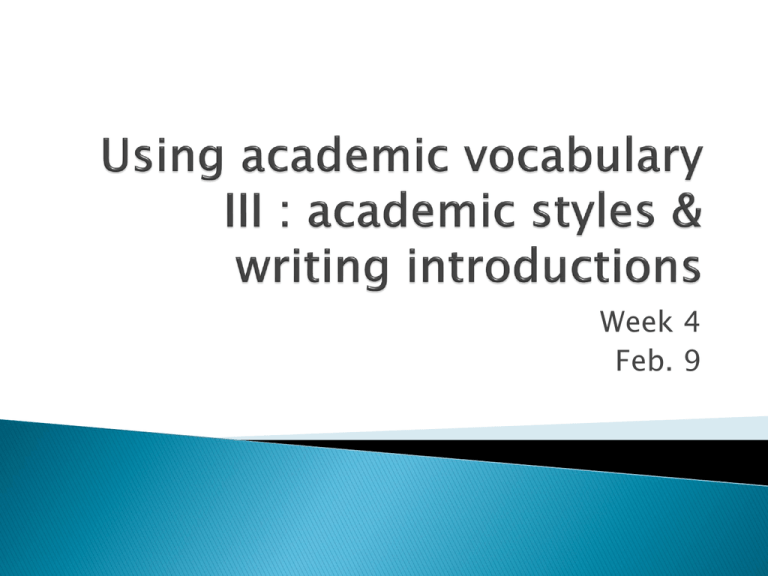
Week 4 Feb. 9 Introductions ◦ Establishing a research territory ◦ Creating a niche Academic Vocabulary III ◦ Editing for academic style Reasons why articles are rejected: ◦ The research does not make a sufficiently large contribution to the “body of knowledge” (i.e., to the literature) ◦ The conceptual framework (i.e., the literature review is not well developed, lacks precise definitions or core constructs, lacks compelling theoretical motivation for stated hypotheses. ◦ The methodology used in the study is seriously flawed (e.g., the sample is too small or the reliability and validity of measure are questionable) ◦ The author’s writing style is disorganized or the article is not structured properly. (Kotzé, 2007, p 1-2) 1. 2. 3. Create-A-Research-Space (CARS) (Swales, 1990) Establish a research territory Establish a niche Occupy the niche TASK TWO ◦ Look at the sample introduction and the following questions with a partner P331-333 HO Other introductions (such as in engineering) focus on problems, issues, uncertainties in the real world (P335). ◦ Which sentences establish the research territory? (Move 1a) (sentences 1-3) ◦ Which sentences establish the niche? (Move 2) (sentences 4-8) Implications are part of the niche See the original article to see how further implications were outlined (PDF: Sections 1.1, 1.2, 1.3) Look at the introduction in one of the journal articles your brought ◦ Identify any of the CARS moves ◦ Was any move skipped, in a different order, or approached in a different way for your field? Look at the introduction in your second journal ◦ Identify any of the CARS moves ◦ How were the moves similar or different from the first article? Discuss your findings with a partner Establishing a niche ◦ How is this related to past literature? And so we’ll continue this next week when we talk the lit review. Practical elements that can accomplish this (pdf, p. 819 for examples): 1. First state the broad theme or topic of the study 2. Explain the academic and practical importance of this article/study. 3. Summarize the available literature and cite important previous studies that are relevant or that were replicated. 4. Indicate the more important gaps, inconsistencies, and/or controversies in the literature that this study will address. 5. Give a clear indication of the core research question/problem, specific research objectives, the context of the study being conducted, the units of analysis. 6. Provide an outline of the structure of the rest of the article. (Kotze, 2007, p 7) Possible but not recommended near beginning of intros: ◦ ◦ ◦ ◦ The purpose of this paper is to … This paper describes and analyzes … My aim in this paper is to … In this case report, we discuss … Why not start this way? ◦ Goal of competing for readership; you may not have interested them yet Where is such a statement more likely? ◦ Typically at the end of a research introduction (Swales & Feak, 2012, p 327) Small phrases tend to reoccur (with variants) when claiming centrality of an issue: (Swales & Feak, 2012, p 339) Let’s try another phrase from your writing in Google to see how common it is Editing for academic style, when we return Tendency to use single verbs versus phrasal verbs: ◦ We came up with a model that… developed a model that…. ◦ We _________ P18-19 HO Use rich and developed noun phrases In the final boxes, what are advantages both ways? language the language of scientific communication English as the international language of scientific communication the emergence of English as the international language of scientific communication The emergence of English as the international language of scientific communication has been widely documented. English has emerged as the international language of scientific communication. This phenomenon has been widely documented. (Swales & Feak, 2012, p 339) Use active voice versus passive where possible ◦ Alcoholism among women has been extensively studied. Who was interested and studied? ◦ Since 19__, researchers (e.g., __, __) have studied alcoholism among women extensively. When might you choose to use the former or the latter ◦ To check yourself, search your document for forms of to be Use strong verbs to revitalize the sound of your writing: ◦ The league gave Roger Clemens, the New York Yankees pitcher, a $10,000 fine for arguing for an umpire. ◦ The league slapped Roger Clemens, the New York Yankees pitcher, with a $10,000 fine for arguing for an umpire. ◦ How is the feeling and “voice” different between these? Consider the list of Active Verbs…what are weaker verbs that you tend to use instead? Active Verbs HO (Ballenger, 2007, p 235) Use academic vocabulary, but avoid clutter. How could you rewrite to keep the meaning but cut unnecessary words? ◦ The implementation of the revised alcohol policy in the university community is regrettable at the present time due to the fact that the administration has not facilitated sufficient student input, in spite of the fact that there has been attempts by the people affected by this policy to make their objections known in many instances. (55 words) (Ballenger, 2007, p 237) Revised to avoid the clutter… ◦ The implementation of the revised alcohol policy in the university community is currently regrettable because the administration has not facilitated sufficient student input, although people affected by this policy have frequently tried to make their objections known. (37 words) ◦ In spite of many students objecting to the implementation of the revised alcohol policy in the university community, the administration hasn’t facilitated their input sufficiently. (25 words) (Ballenger, 2007, p 237) Some academic phrases have become old and boring, ◦ think of soda sitting in the fridge that no longer fizzes ◦ or milk that’s been in there too long, even though you don’t smell it yet ◦ or think of a something a professor has said…over and over and… …and over ◦ or think of something you say over and over, such when you TA and want the class’s attention… Active Verbs HO P22-25 HO (Ballenger, 2007, p 237) 1. 2. 3. 4. 5. 6. Check for phrasal verbs and can be replaced with a single verb Check for noun phrases that can be expanded Check for overuse of passive tense that can be replaced with active tense Check for weak verbs, like is, do, have, gave Check for clutter (too many words) Check for tired phrases that can be replaced with fresher alternatives Now take a look at your writing. Can you find one or two of these that seem to be a tendency? Should you avoid contractions? Should you avoid “I”? Consider the purpose, audience and intended impression (Plagiarism, Jose) ◦ What is the purpose and audience? ◦ What does this article accomplish using contractions? and “I”? Do the mechanics of the paper noticeably impede comprehension at any point? Is the paper written in a clear and coherent manner? Does sentence or discourse structure noticeably impede comprehension in any way? Does the paper incorporate any unconventional register(s) and does this impact its effectiveness? Is the paper itself textually cohesive? That is, is the paper written in a clear and coherent manner with logical transitions among sentences and paragraphs? Grammar & wording Literature review ◦ Goes too quickly to the study issue without situating it in the related research ◦ Insufficient review of the literature, causing the reviewer to note oversights & misunderstandings ◦ Personal definitions rather than giving attribution Analysis & design ◦ Claims about results were problematic for the research design ◦ Sample size too small for the complexity and claims ◦ Causes and effects in the design not well addressed Bring two articles from a journal or database in your discipline, similar to what you are writing (hard copy or on your computer) Keep the same partner as last week Use the same workshopping instructions This week’s global issue to consider: ◦ Introductions: Creating a territory and a niche This week’s local issue to consider: ◦ Editing for Academic Style Two have signed up to meet me today. (From Liu & Hansen, 2002, p 138)
